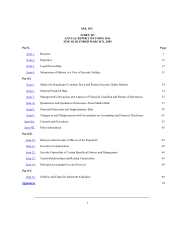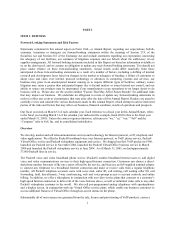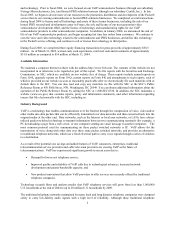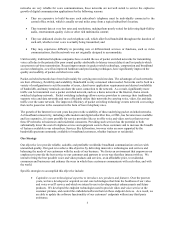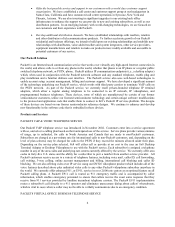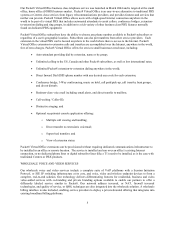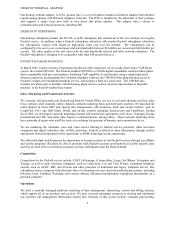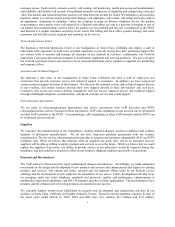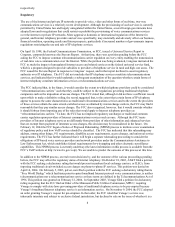8x8 2005 Annual Report Download - page 5
Download and view the complete annual report
Please find page 5 of the 2005 8x8 annual report below. You can navigate through the pages in the report by either clicking on the pages listed below, or by using the keyword search tool below to find specific information within the annual report.2
and technology. Prior to fiscal 2004, we were focused on our VoIP semiconductor business (through our subsidiary
Netergy Microelectronics, Inc.) and hosted iPBX solutions business (through our subsidiary Centile, Inc.). In late
fiscal 2003, we began to devote more of our resources to the promotion, distribution and development of the Packet8
service than to our existing semiconductor or hosted iPBX solutions businesses. We completed several transactions
during fiscal 2004 to license and sell technology and assets of these former businesses, including the sale of our
hosted iPBX research and development center in France, the sale and license of our next generation video
semiconductor development effort, and the license of technology and manufacturing rights for our VoIP
semiconductor products to other semiconductor companies. In addition, in January 2004, we announced the end of
life of our VoIP semiconductor products, and began accepting last time buy orders from customers. We continue to
own the voice and video technology related to the semiconductor and iPBX businesses, and utilize this technology
in the Packet8 service offering, and continue to sell or license this technology to third parties.
During fiscal 2005, we completed three equity financing transactions for gross proceeds of approximately $38.5
million. As of March 31, 2005, we had cash, cash equivalents, restricted cash and investments of approximately
$31.8 million as compared to $14 million at March 31, 2004.
Available Information
We maintain a corporate Internet website with the address http://www.8x8.com. The contents of this website are not
incorporated in or otherwise to be regarded as part of this report. We file reports with the Securities and Exchange
Commission, or SEC, which are available on our website free of charge. These reports include annual reports on
Form 10-K, quarterly reports on Form 10-Q, current reports on Form 8-K and amendments to such reports, each of
which is provided on our website as soon as reasonably practicable after we electronically file such materials with or
furnish them to the SEC. You can also read and copy any materials we file with the SEC at the SEC’s Public
Reference Room at 450 Fifth Street, NW, Washington, DC 20549. You can obtain additional information about the
operation of the Public Reference Room by calling the SEC at 1.800.SEC.0330. In addition, the SEC maintains a
website (www.sec.gov) that contains reports, proxy and information statements, and other information regarding
issuers that file electronically with the SEC, including us.
Industry Background
VoIP is a technology that enables communications over the Internet through the compression of voice, video and/or
other media into data packets that can be efficiently transmitted over data networks and then converted back into the
original media at the other end. Data networks, such as the Internet or local area networks, or LANs, have always
utilized packet-switched technology to transmit information between two communicating terminals (for example, a
PC downloading a page from a web server, or one computer sending an e-mail message to another computer). The
most common protocol used for communicating on these packet switched networks is IP. VoIP allows for the
transmission of voice along with other data over these same packet switched networks, and provides an alternative
to traditional telephone networks, which use a fixed electrical path to carry voice signals through a series of switches
to a destination.
As a result of the potential cost savings and added features of VoIP, consumers, enterprises, traditional
telecommunication service providers and cable television providers are viewing VoIP as the future of
telecommunications. VoIP has experienced significant growth in recent years due to:
• Demand for lower cost telephone service;
• Improved quality and reliability of VoIP calls due to technological advances, increased network
development and greater bandwidth capacity; and
• New product innovations that allow VoIP providers to offer services not currently offered by traditional
telephone companies.
Technology research firms and analysts predict that VoIP telephony services will grow from less than 1,000,000
U.S. households at the end of 2004 to up to 20 million U.S. households by 2009.
The traditional telephone networks maintained by many local and long distance telephone companies were designed
solely to carry low-fidelity audio signals with a high level of reliability. Although these traditional telephone



